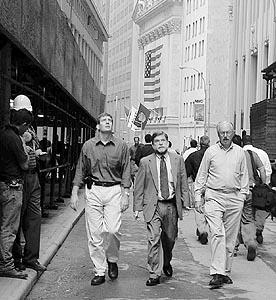![[Metroactive Features]](/features/gifs/feat468.gif)
[ Features Index | San Jose | Metroactive Central | Archives ]
What, Exactly, Do You Mean by 'Normal'?
By Lauren Barack and Michael Learmonth
THE NEIGHBORS are having a party. Women in tank tops and jeans sit on the ledge of the roof across our street holding bottles of beers. Thick men in oxford shirts shout loud declarative sentences, careful not to spill the contents of plastic cups. Yet on the sidewalk immediately below them, National Guardsmen are loading and unloading snorting Army trucks filled with anything a rubble rat might need: a bottle of water, a new respirator filter or maybe just a clean pair of shorts. The Seamen's Church remains one of the more active staging areas for the delivery of supplies to Ground Zero, which is visible as a luminous column of smoke just a few rooftops away.
Normal is how New Yorkers are being encouraged to act just two weeks after the attacks. We are being told to eat out--even if our neighborhood restaurants no longer accept credit or ATM cards because the phone lines are down. We are asked to frequent Broadway plays--though so many are closing because of poor sales that we can't trust the listings in the newspapers. Schools have reopened, even as statistics are being generated about how many children lost parents on Sept. 11. An estimated 1,500 lost a parent from the Cantor Fitzgerald firm alone.
The city is moving along, but with a noticeable limp. "Matt, how are you getting to school tomorrow?" one parent asks the young son of another on our street tonight. The child's mom shrugs. "Maybe the ferry?"
For those who live above 14th Street, going back to work is simple. The subways still run, and while there is an occasional smoky flavor to the air, the only disturbance for many is the glaring blank space in the sky downtown. But below 14th Street, the city has changed. On Monday, with the opening of the Stock Exchange, new subway maps were handed out by Manhattan Transit. Where the lines once met in a tangled snarl on the lower west tip of Manhattan, there is now a wide berth of green. Some lines are now routed through the closed Chambers Street Station, which once gave access to one end to the World Trade Center, and which somehow managed to escape ruin. The usual coversational buzz in the cars turns quiet as the train moves through the stop like an attraction on the Disneyland monorail.
The walk to work is now longer for many who work at the Stock Exchange or in the thousands of businesses allowed back into their checked-and-now-deemed-safe buildings in the Wall Street area. They are routed along Nassau Street to Wall, where George Washington took the oath of office in 1789. Looking west down Liberty Street, a twisted five-story slice of metal stands, the remnant of Tower Two, which seems to hang like a marionette suspended by invisible cables. Some people pause, stand behind the chain-link fence, and continue with their morning coffee to start a normal day of work.
The American Heritage Dictionary (these are patriotic times, after all) describes normal as stressing "adherence to an established level or pattern that is associated with well-being ..."
But well-being is not the first feeling that hits us in SoHo as we glance at the pile of out-of-focus prints of the World Trade Center ablaze selling for $3 to $10 depending on size. The street vendors barely took a week to fulfill a predicted demand for disaster-related merchandise. The first iterations of T-shirts to start selling in Chinatown lost some sensitivity in the translation. "I Can't Believe I Made It," read one of the first, in front of an image of the American flag and the two towers. Chintzy New York skyline postcards are flying off the racks.
On Saturday, for the first time in almost two weeks, we picked up the phone and heard a dial tone. We had messages. Yesterday our first newspaper arrived since the disaster. Slowly, normal life is returning to downtown. Rescue workers commute home on the six train, covered in sweat, but smiling. The cops are even loosening up a little. A group of three, dressed in ceremonial uniforms with kilts and white spats, stood on the corner Sunday night having a pint. They'd just come from the prayer ceremony at Yankee Stadium, we overheard one explain to a woman as we walked home from grocery shopping. She offered her condolences, they thanked her, and then went back to their drinking. We could hear them laughing as we walked up the street.
[ San Jose | Metroactive Central | Archives ]
Copyright © 2001 Metro Publishing Inc. Metroactive is affiliated with the Boulevards Network.
For more information about the San Jose/Silicon Valley area, visit sanjose.com.
![]()

Photograph by Lauren Barack
Editor's Note: Former Metro writers Michael Learmonth and Lauren Barack live seven blocks away from the destroyed World Trade Center. This is the second in a series of weekly dispatches to Metro.
From the September 27-October 3, 2001 issue of Metro, Silicon Valley's Weekly Newspaper.